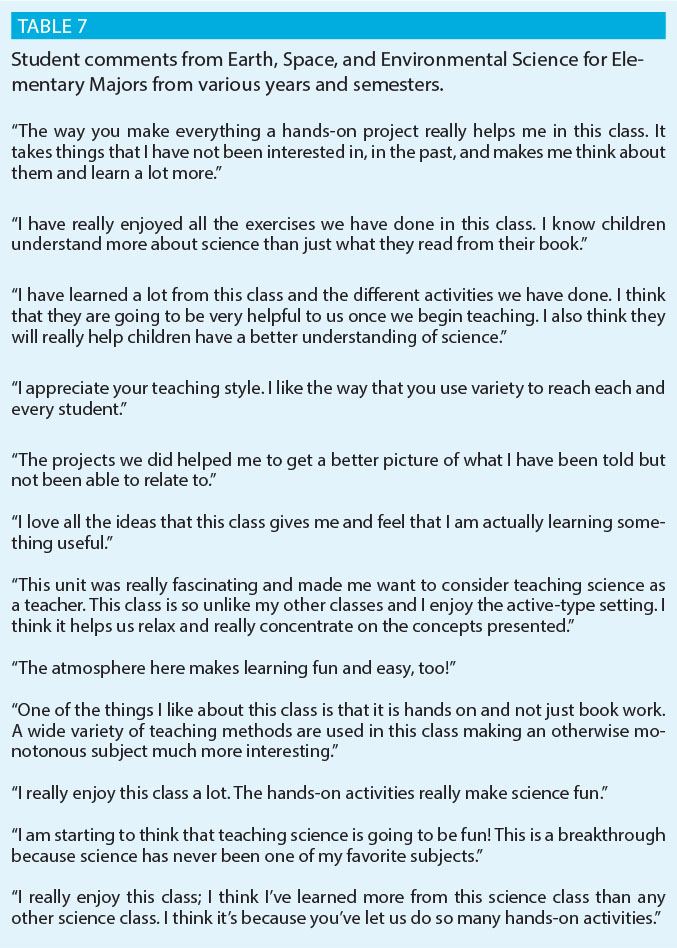Student-Centered Learning in an Earth Science, Preservice, Teacher-Education Course

In an effort to get elementary teachers to teach more science in the classroom, a required preservice science education course was designed to promote the use of hands-on teaching techniques. This paper describes course content and activities for an innovative, student-centered, Earth science class. However, any science-content course could be adapted in a similar manner to include more student-centered activities.
Elementary education majors do not generally have the best attitudes toward science. In a poll of 70 students taken at the beginning of the semester for the last three semesters, 27 liked science, 23 did not, and 20 did some of the time. An Earth-science-content course was designed using hands-on activities and more student-centered learning in an attempt to convince future teachers that they really do like science. Basic topics in the Earth sciences are covered, including astronomy, geology, meteorology, and hydrology. Even though this paper discuses activities in an Earth science class, any sciencecontent course could be adapted in a similar manner to include student-centered activities.
Evolution of the course
From 1999–2001, university faculty members held a series of workshops for inservice teachers to learn Global Learning and Observations to Benefit the Environment (GLOBE) protocols and become certified as GLOBE instructors. As part of GLOBE, teachers learned the proper way to use lab equipment, gather and analyze data, submit data to an international database via the worldwide web, and access data from other schools for comparative studies. Success of the workshops was evaluated in several ways, including pre- and post-content knowledge exams, pre- and post-self efficacy surveys, GLOBE evaluation forms, and in-house surveys (Avard 2001). Overall, teachers were excited about experiencing environmental science and felt able to pass the knowledge on to their students.
In 1997, the state mandated that preservice teachers take 12 hours of content classes in science plus a science methods course. A portion of the science requirement at the university was already met by two existing general education courses. To complete the requirement, a new course was designed: Earth, Space, and Environmental Science for Elementary Majors (ESE). Because the hands-on methods of the GLOBE Program were so effective during the in-service teacher workshops, and after receiving a grant from NASA Opportunities for Visionary Academics (NOVA), the course was designed, from the beginning, to incorporate hands-on, student-centered activities. NOVA teaching strategies focus on hands-on, inquiry-based learning activities (NOVA 2007), and funding from NOVA allowed faculty members to design an original course using these teaching techniques.
“Student-centered” or “learner-centered” learning is mentioned in many standards and curricula, yet there is not one universal definition for the term(s). It means different things to different people (Paris and Combs 2006). Many believe that student-centered learning is more effective than instructorcentered learning because it requires students to learn on their own rather than having to try to simply listen and assimilate information (Lord et al. 2002; Mahendra et al. 2005; Norman and Spohrer 1996; Prince and Felder 2007; Windschitl 2006). Many studies support this belief, but others do question it (Giles et al. 2006; Estes 2004). In reality, a diversity of well documented student-learning styles exists. Using the Felder-Silverman Learning Styles Model (Felder 1993) and Soloman’s questionnaire (characteristics and results in Table 1) in a study, Montgomery (1995) found that learning styles and teaching styles often are not compatible: 67% of students learned best actively, yet lectures were typically passive; 57% of students were sensors, yet were taught intuitively; 69% of students were visual learners, yet lectures were primarily verbal; and 28% of students were global thinkers, yet faculty members seldom focused on the “big picture.’’ Weimer (2002) believes that there are five elements of learner-centered education: (1) shared power between instructors and students, (2) course content as the means to knowledge and not its end, (3) role of the teacher as facilitator, (4) shifting the responsibility for learning, and (5) using evaluation to promote learning. This author interprets the phrase “student-centered learning” to mean activities, both guided and inquiry-based, designed to foster hands-on learning while maintaining open lines of communication; the teacher is primarily a facilitator rather than a lecturer. Learning includes both content knowledge and higher-order thinking skills.
The ESE course at the university is a required content course with one of its primary goals being to expose students to learner-centered teaching techniques. This was determined to be an important goal because elementary teachers are expected to teach classes using handson, interactive techniques (NRC 1996) but have not generally been exposed to science classes taught in this manner; it is difficult to teach in a manner to which one has never been exposed. The hope is that students learning in a studentcentered manner will later teach in the same manner. Science prerequisites for ESE, General Biology and General Physical Science, are typically taught in a traditional lecture-lab-type format. ESE was designed using a different method of teaching incorporating the hands-on, student-centered approach rather than the standard lecture-lab format. The course was designed to cover basic topics in the fields of astronomy and geology followed by GLOBE topics including GPS, meteorology, hydrology, remote sensing, soils, and a supplemental GLOBE program designed by ESRI: the prepackaged geographic information system ArcVoyager. Because a large portion of the course is dedicated to teaching GLOBE protocols, students leave the course certified as GLOBE instructors, which gives these new teachers entering the workforce a competitive advantage. GLOBE also provides students (preservice teachers) with some materials for their classrooms. It is important to note that this is not an education methods course but a regular, collegelevel content course; there is a separate science-methods class that elementary education students must complete.

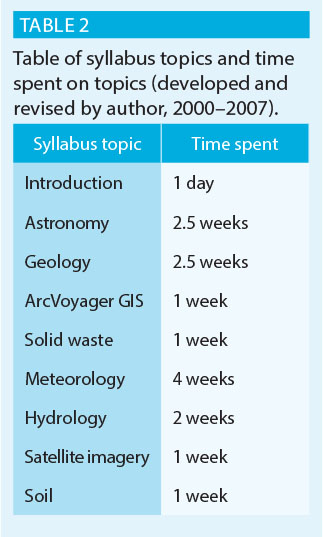
Earth, Space, and Environmental Science for Elementary Majors
It is a common belief that many elementary teachers shy away from teaching science in their classrooms because they are not comfortable with the material or the teaching techniques. To make the ESE class more hands on, the class does not meet on a traditional lecture-lab schedule. MWF sections meet for an hour and a half each day, while the TTh sections meet for at least two hours. This allows ample time each class period to introduce a topic, perform various hands-on activities, and discuss and assess results. There is no textbook for the course, so a variety of teaching methods are incorporated including use of the internet for research and discussion, guided activities using maps, making models, and other daily, hands-on activities. There is a laboratory manual that students are required to bring to class every day that contains descriptions of and worksheets for the daily activities. A guide of topics, activities, and time spent on each topic can be seen in Table 2.
To illustrate the format of the class, the curriculum for the meteorology unit will be described. Before the unit begins, students must complete a weather primer developed by the instructor that includes 65 questions about weather and the atmosphere. Students can obtain the answers from any sources as long as they are reputable. Students are given topics that they will be responsible for discussing with the class. The weather primer acts as an outline for the entire meteorology unit, so all hands-on activities are associated with topics already researched by students. Some sample questions from the primer can be seen in Table 3.
The unit begins with a discussion about why weather and the atmosphere are being included in an environmental science class. This incorporates a teacher-led discussion about environmental laws governing air quality and air pollution. After the general introduction, students discuss their topics with the teacher and class in a time span of approximately four weeks; meteorology is one of the longer units in the course. As the topics are discussed, appropriate instrumentation is introduced. Students learn to use various meteorological instruments including barometers, sling psychrometers, cloud and contrail charts, and maximum/minimum/ current-temperature thermometers by following GLOBE protocols. They also collect data for two weeks and submit them to the GLOBE website. Topics covered during the meteorology unit include the makeup and structure of the atmosphere; atmospheric pressure; humidity; cloud formation, identification, and coverage; precipitation; fronts; tornadoes; hurricanes; El Niño/La Niña; weather satellites; and forecasts generated by computer models. Demonstrations are also included to further promote understanding. For example, one of the demonstrations used during the discussion of atmospheric pressure is the Egg in the Bottle activity.
As a capstone activity to put all of the pieces together, students visit several websites that have live weather data and use their knowledge of meteorological concepts to interpret the information. Websites include those of the Oklahoma Climatological Survey (http://climate. ok.gov), National Oceanic and Atmospheric Administration (www.spc.noaa. gov/products/outlook/day1otlk.html), University Corporation of Atmospheric Research (www.rap.ucar.edu/weather/ satellite), Weather Channel (www.weather.com), and American Meteorological Society (www.ametsoc.org/dstreme). Sample questions from this activity can be seen in Table 4.
Another capstone activity is use of the website of the Oklahoma Mesonet (www.mesonet.org 2007). Students compare various parameters (average temperature, average rainfall, etc.) between a county in the western panhandle of the state with the county they are in (in the southeast corner). Figure 1 is an example of a map from the website. It becomes readily apparent to students that the weather varies quite dramatically across the state both in the short term and long term. They analyze day-to-day weather variations such as the changes in temperature and wind direction that occur when a front passes through. They also see longer-term climate variability across the state.
The capstone activities for each unit are designed to foster higher-level thinking. Students gain content knowledge as each unit progresses; the final, capstone activities give students the opportunity to use this new knowledge to promote critical-thinking skills.
Each subsequent unit is structured similarly to the meteorology unit but incorporates different topic-appropriate activities. During each semester, students must also complete a group project (two to three people), on a topic of their choice, which includes reviewing relevant literature and writing a research paper, collecting data and plotting it on a computer-generated graph, writing a graph analysis, assembling the information into a PowerPoint presentation, and presenting the information to the class.
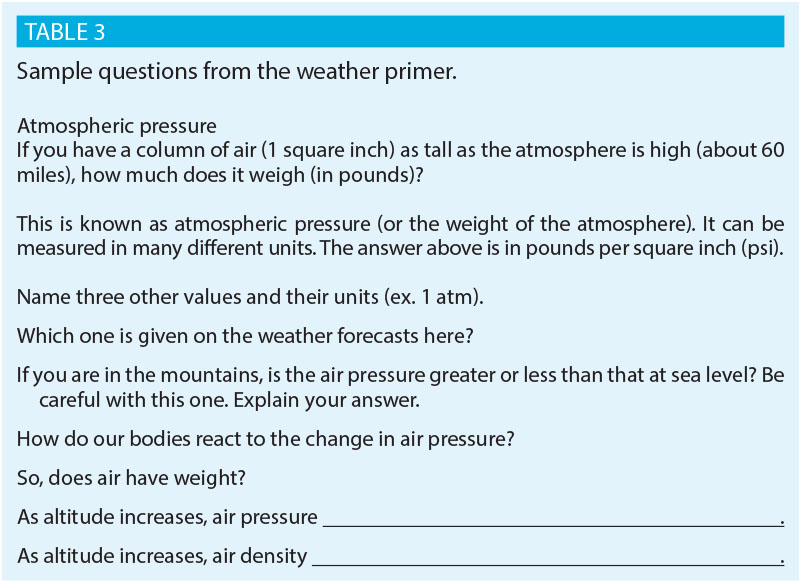
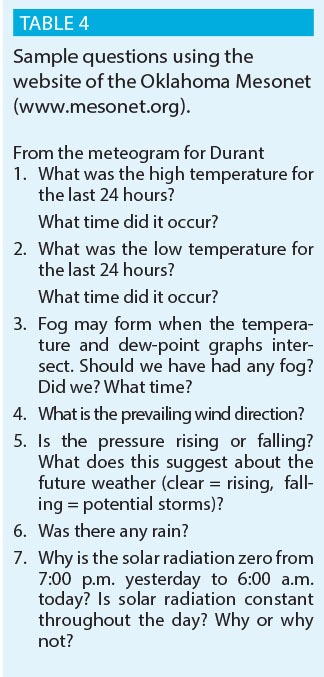

Results
Since the spring of 2003, a pre- and posttest have been given in all sections of the course for assessment purposes. One hundred sixty-four students took both the pretest and posttest. The test comprises 25 multiple-choice content questions that address all of the topics covered in the course. Pretest scores were compared to posttest scores for each student using a paired t-test. Results are shown in Table 5 and, statistically, are highly significant (p < 0.001). This indicates that students generally enter the course having had little exposure to the Earth sciences and leave with a much broader knowledge base.
The science subarea of the State Subject Area Test (SSAT) exam for elementary-education majors tests a student’s collective knowledge in the sciences. Table 6 compares the science subarea scores of students having had ESE at the university with institutional and statewide mean scores in the science subarea over a five-year period. One hundred forty students who had taken ESE took the exam. Data indicate that students having taken this class do significantly better (p = 0.01) on the science portion of the exam than students who have not taken the course. Results were not as significant (p = 0.06) when comparing scores to the state mean.
In the course, student learning is assessed using a variety of methods including grades on daily activities, participation during activities, quizzes, homework, and the group project. At the conclusion of each unit, students must write a reflection describing their feelings about all activities conducted within that unit. Though they are not asked to do so, many students will also comment about the teaching format of the class. A small sample of these comments is shown in Table 7. Even though anecdotal evidence is not generally an appropriate assessment instrument, student comments are included because they illustrate important shifts in attitude or perception toward learning methods. These include a more accepting attitude toward learning science; the understanding that not only do students learn effectively using hands-on techniques, but that their students will benefit from similar learning experiences; that not all students learn in the same way— using a variety of teaching methods is a good way to eventually reach all students; and that having dialogues with a teacher creates a comfortable learning environment that fosters intellectual growth and encourages the asking of questions. It is apparent in many of the comments that students entered the class with fairly negative attitudes toward science, but were beginning to gain a more positive attitude. By sparking an interest in the hands-on activities, students were less loathsome of learning new scientific material.
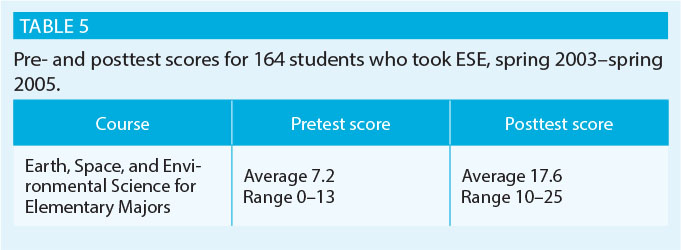

Discussion
Using a variety of assessment tools including pre/posttesting, scores on state certification exams, and student comments, it can be clearly demonstrated that elementary-education majors benefit from taking a science class in which student-centered learning is the primary teaching technique. Students not only learn more information and retain it better, but they also enjoy learning science, some for the first time in their lives. Many have found science to be dull and boring but, when presented in a different manner, have found it to be interesting and exciting. By changing the attitude of prospective teachers toward science, they, in turn, may be more likely to teach more science in their own classrooms. When the 70 students mentioned in the introduction were again polled at the end of each semester and asked if they liked science, 55 now said that they did, 0 did not, and 15 did some of the time! This is markedly different from the responses given at the beginning of the semesters and reflects an important shift in attitude
The GLOBE Program is especially well suited for a student-centered learning format. It has been designed with K–12 teachers in mind and so is a ready-to-go environmental science teaching plan. The Teacher’s Guide can be found online on the GLOBE website (www.globe.gov), and includes content, lesson plans, worksheets, helpful hints, and information about how the different GLOBE activities and protocols meet the National Science Teaching Standards. The website is user friendly and contains a tremendous amount of information, including maps, online worksheets for data entry via the web, graphing exercises, quizzes, contact information for other GLOBE schools, and links to many useful resources.
Another fascinating aspect of The GLOBE Program is that it offers students a great way to become civically involved. Civic engagement is a fairly new, multidisciplinary concept that is becoming a requisite for institutions of higher education (Brisbin and Hunter 2003; Persell and Wenglinsky 2004); students become actively involved in the community. As students collect data and submit it to the GLOBE database, they are participating in civic engagement because their data will be used by scientists around the world. Some GLOBE schools also have students perform soil- or water-quality tests for citizens of the local community. In the science classroom, opportunities for civic engagement are nearly limitless; there are many ways students may be engaged in community matters to encourage civic involvement and broaden student exposure to issues of public concern. GLOBE provides students with the opportunity to become civically involved
There are many other programs (Project Wild, NASA; etc.) that provide versatile means of demonstrating effective, hands-on, teaching techniques to preservice education students. It is critical for college faculty members involved in science education to assist future teachers, especially those who will be in elementary grades, in becoming more comfortable and knowledgeable with hands-on science. This will likely increase the frequency with which the new teachers teach science in their elementary classrooms and benefit the overall quality of education in elementary schools.
More research needs to be done to examine the teaching methods of elementary teachers who have been exposed to student-centered learning. Is one student-centered science class enough to make a difference, or are more required to make long-term impacts on teaching technique? The university will soon be participating in a follow-up study conducted by the NOVA group to examine teaching techniques of elementary teachers having taken a NOVA course compared to elementary teachers who had not. The study will involve 30 institutions of higher learning and 180 inservice elementary teachers (Mason pers. comm.). One of the goals is to “determine short- and long-term impacts of undergraduate science courses on elementary teachers.” This study will help decipher whether or not students learning in student-centered environments take it to the next level and actually teach in a student-centered manner.
